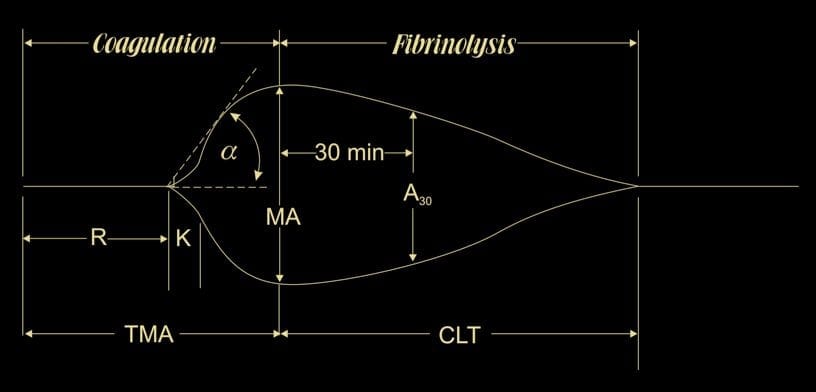CICM SAQ 2015.2 Q8
Question
With respect to thromboelastography and haemostasis:
With reference to the parameters labelled in Figure 1:
- CT (or R) (CLT in this figure)
- CFT (or K)
- Alpha angle
- MCF (or MA)
- LI30 (or LY30 or CL) (A30 in this figure)
- a) Explain what each parameter represents and what it measures. (60% marks)
Review the following thromboelastograms labelled A – E.
Diagram A represents a normal coagulation profile
- b) Describe the coagulation status indicated by diagrams B – E. (40% marks)
Answer
Answer and interpretation
a) Explain what each parameter represents and what it measures. (60% marks)
R (reaction time or clotting time) is the time elapsed until first measurable clot forms (amplitude of 2mm) and indicates the initiation of haemostasis and is dependent on presence of clotting factors.
K (kinetics or clot formation time) is the time taken to achieve a certain level of clot firmness (amplitude of 20mm) and indicates amplification of the clotting process. Dependent on fibrinogen.
Alpha angle reflects the speed of fibrin accumulation. Dependent on fibrinogen.
MA/MCF is the maximum amplitude or maximum clot firmness and is the highest vertical amplitude of the TEG tracing. Dependent on platelets and fibrin.
LY30 /CL (clot lysis) is the percentage of amplitude reduction 30 min after maximum amplitude and is a measure of fibrinolysis.
b) Describe the coagulation status indicated by diagrams B – E. (40% marks)
B – Anticoagulant therapy or factor deficiency
C – Platelet dysfunction or thrombocytopaenia or fibrinogen deficiency
D – Fibrinolysis e.g. use of t-PA
E – Hypercoagulable state
- Pass rate: 69%
- Highest mark: 9.3

Examination Library
CICM
Chris is an Intensivist and ECMO specialist at The Alfred ICU, where he is Deputy Director (Education). He is a Clinical Adjunct Associate Professor at Monash University, the Lead for the Clinician Educator Incubator programme, and a CICM First Part Examiner.
He is an internationally recognised Clinician Educator with a passion for helping clinicians learn and for improving the clinical performance of individuals and collectives. He was one of the founders of the FOAM movement (Free Open-Access Medical education) has been recognised for his contributions to education with awards from ANZICS, ANZAHPE, and ACEM.
His one great achievement is being the father of three amazing children.
On Bluesky, he is @precordialthump.bsky.social and on the site that Elon has screwed up, he is @precordialthump.
| INTENSIVE | RAGE | Resuscitology | SMACC


